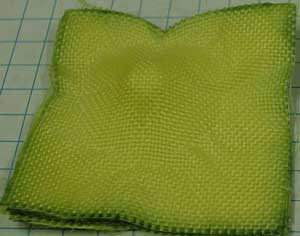ABERDEEN
PROVING GROUND, Md. -- Liquid
armor for Kevlar vests is one of the newest technologies
being developed at the U.S. Army Research Laboratory to
save Soldiers' lives.
 |
|
Kevlar fabric with shear
thickening fluid, after impact by a fragment
simulating projectile. |
This type of
body armor is light and flexible, which allows soldiers
to be more mobile and won't hinder an individual from
running or aiming his or her weapon.
The key component of liquid armor is a shear thickening
fluid. STF is composed of hard particles suspended in a
liquid. The liquid, polyethylene glycol, is non-toxic,
and can withstand a wide range of temperatures. Hard,
nano-particles of silica are the other components of STF.
This combination of flowable and hard components results
in a material with unusual properties.
"During normal handling, the STF is very deformable and
flows like a liquid. However, once a bullet or frag hits
the vest, it transitions to a rigid material, which
prevents the projectile from penetrating the Soldier's
body," said Dr. Eric Wetzel, a mechanical engineer from
the Weapons and Materials Research Directorate who heads
the project team.
To make liquid armor, STF is soaked into all layers of
the Kevlar vest. The Kevlar fabric holds the STF in
place, and also helps to stop the bullet. The saturated
fabric can be soaked, draped, and sewn just like any
other fabric.
Wetzel and his team have been working on this technology
with Dr. Norman J. Wagner and his students from the
University of Delaware for three years.
"The goal of the technology is to create a new material
that is low cost and lightweight which offers equivalent
or superior ballistic properties as compared to current
Kevlar fabric, but has more flexibility and less
thickness," said Wetzel. "This technology has a lot of
potential."
Liquid armor is still undergoing laboratory tests, but
Wetzel is enthusiastic about other applications that the
technology might be applied to.
"The sky's the limit," said Wetzel. "We would first like
to put this material in a soldier's sleeves and pants,
areas that aren't protected by ballistic vests but need
to remain flexible. We could also use this material for
bomb blankets, to cover suspicious packages or
unexploded ordnance. Liquid armor could even be applied
to jump boots, so that they would stiffen during impact
to support Soldiers' ankles."
In addition to saving Soldiers' lives, Wetzel said
liquid armor in Kevlar vests could help those who work
in law enforcement.
"Prison guards and police officers could also benefit
from this technology," said Wetzel. "Liquid armor is
much more stab resistant than conventional body armor.
This capability is especially important for prison
guards, who are most often attacked with handmade sharp
weapons."
For their work on liquid armor, Wetzel and his team were
awarded the 2002 Paul A. Siple Award, the Army's highest
award for scientific achievement, at the Army Science
Conference.
|